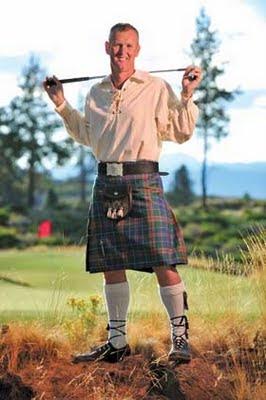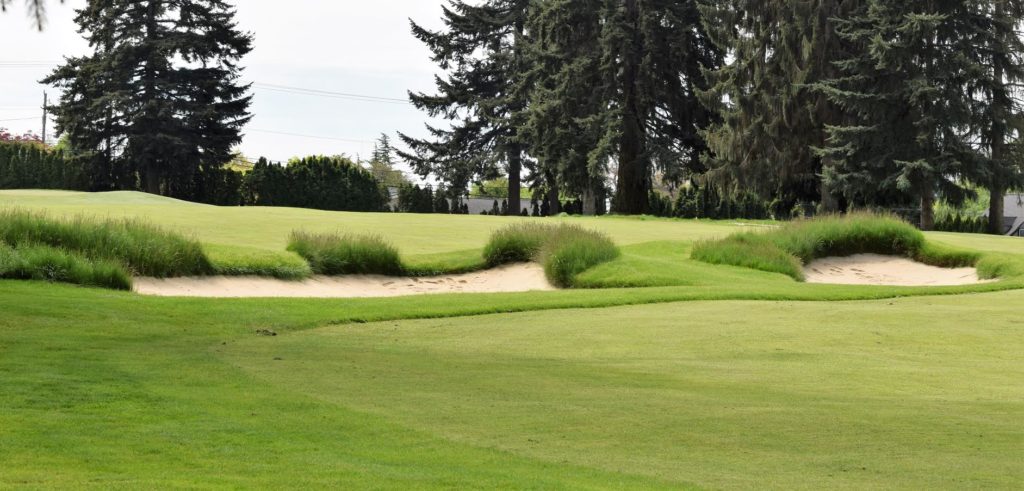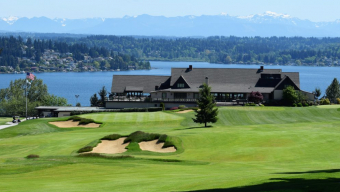Ninety-three-year-old Sand Point Country Club is one of the five oldest golf courses in Seattle and has had its share of changes over the years. But the “new” SPCC is a sight to behold.
Literally.
Though modest in length, just 6,200 yards from the tips, and minus any water hazards, the course located on the hills above what used to be the Seattle Naval Air Station, has some views of Lake Washington and the Cascades that will knock your Jox Sox off.
A sixth-month course makeover debuted on June 6 – a little tardy because of inclement weather in November and December and the COVID-19 virus this year. Except for the par-3 11th hole (a new version will debut in October) SPCC members are now able to experience the 18-hole layout under strict virus-related stipulations. Masks and social distancing are required, golfers can’t show up more than 30 minutes prior to their tee time, masks can be removed on the first tee and replaced after the final putt of the round. No exceptions, thank you.
Even with the delays and new rules it was well worth the wait.
“I love the course! Love the look! Love the new features that give it a cool, older golf- style feel,” said Jim Na, a former Mariners Assistant General Manager. “I love the wood flagsticks, the clock, the tee-markers, and the views are off the chart.”
And to think the initial plan was to do a bunker makeover.
”We had a plan for quite a few years to do a bunker renovation,” former Golf Course Superintendent Craig Sampson said. “Then we discussed the idea of a re-design option and decided it was a good idea to try to get several architects involved. We decided to talk to some well-known architects and that’s when David McLay Kidd’s name came up.
Kidd, a Scotsman and now lives in Bend, Ore., has become one of most popular golf course architects in the world. Bandon Dunes in Oregon and Gamble Sands in Washington are among his world-renowned DMK-designed courses.
After several attempts, Sampson connected with Kidd via phone and pitched the SPCC project. Kidd accepted an offer to visit the course.
“When we drove in, I looked around and asked, ‘Why haven’t I heard of this place’?” Kidd recalled. “What other courses in the country, or even in the world, do you get a view like this? I have traveled the world looking at golf courses and there aren’t many with a view like this. The views were the first thing that caught my eye. I could see a golf course that had unrealized potential.”
The project did not make SPCC a “new” course, but it sure made it a “different” course. Minus a few trees that were on their last roots anyway, the old course has a new look.
As Dr. Brian Wong put it, “Sand Point’s reputation before the makeover was: hilly, narrow, lots of trees, you better hit it straight or you’re in jail, and small undulating greens.”
And now?


“Sand Point’s new reputation: hilly, wide open, lots of views,, and larger undulating greens. It is more wide open and demands more precision in your shot-making. You can’t get away with a mediocre shot like you used to. The course is now beautiful and treacherous.”
On the eighth fairway, for example, you can see Mt. Baker to the north, the Cascades to the east and Lake Washington from Kenmore almost to the 520 floating bridge.
As for the course itself, 41 bunkers were added along with 15 acres of native area.
“Our objective is to develop comprehensive maintenance that are efficient and sustainable,” said new Golf Course Superintendent Marcus Harness. “We will continue transitioning renovated areas to be more uniform and consistent in playability. However, it may take a season or two for everything to fully mature and establish.”
Among the most noticeable changes:
Bunkers: REAL sand! The previous version was more like dirt, causing the club to bounce far too many times. The new sand is soft and will actually improve with age. The bunkers now have high grass in and around the hazards. Good luck.
Blind shots: The second and eighth holes previously had periscopes to see if the fairway in front of you was clear. The ‘scopes were mediocre at best. Now, there are solar-powered “traffic lights”, showing green when it’s OK to tee off and red when it’s not safe to hit. The lights are controlled by the golfers in each group or automatic on-off if a group forgets to push the buttons.
Throwback look: Wooden flagsticks and single-colored flags are similar to the ones used back in the day, way back to the SPCC debut in 1927.
Pin locations: Red (front), White (middle) and Blue (back) posts are located on the non-par-3 holes to inform golfers which quadrant of the green the pin is located that day.
In addition to all that, the course ratings are different from the various tees.
The Black tee Rating/Slope went from 69.7/129 to 70.6/125; the Black/Blue combo, 69.1/127 to 69.6/123; Blue, 68.3/125 to 69.0/121; Blue/White, 67.6/124 to 67.5/120; White, 66.9/123 to 66.9/118; White/Gold, 63.6/115; Gold, 62.8/113 to 62.9/111.
The yardage was changed from (Black) 6,009 to 6,200; Black-Blue 5,830 to 5,927; Blue 5,667 to 5,709; and Blue-White, 5,455 to 5,375.
The forward tees: White, 5,301 to 5,109; White/Gold, 4,684 to 4,749 and Gold, 4,454 to 4,299 yards.
For the men, the hole-by-hole handicap had just two that stayed the same: No. 4, a par-4, is still the No, 1 handicap hole and No. 18 retained it’s 10th place standing. The uphill 12th hole, a par-4, was the second most-difficult hole on the course, largely because of a terrible green. In fact, the unfair green was totally rebuilt and changed to a par-5.
The greens on Nos. 8 and 16 also were totally replaced. Kudos for that!!
Another notable change are holes 12 and 14. The former 14th tee is now the 12th tee and vice versa. Simultaneous tee shots on the two holes could be interesting.
An aesthetic addition is a handsome new clock installed near the first tee (very cool) .
Not so cool is the ball-gobbling, ankle-high native grass that hides errant shots.
“Tall fescue and native grass areas abound,” Wong noted. “It’s lovely to look at, but balls seem attracted to them and they are like Venus fly traps; you can’t get out.”
A local rule was added: All fescue areas right of the cart path on Holes 2, 4 and 5 shall be played as penalty areas. If your ball is found (good luck) you may play your next shot without penalty, or, if your ball is unable to be found, you may take — with a one-shot penalty — lateral relief, back on the line of relief or play the shot over from the original position
“It’s lovely to look at, but I’ve never lost so many balls!” said Wong, a low-handicap golfer with a sweet-as-sugar swing.
Na, another low-handicapper, said, “Watching the wind blow the fescue is incredible!”
And so, with additional bunkers, fewer trees and high native grass, it’s game-on at Sand Point Country Club. Who needs water hazards, anyway?






















